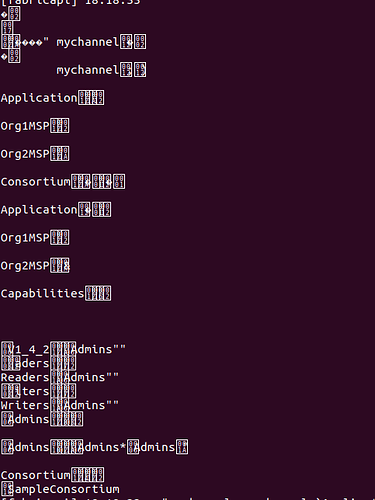TechStack: HyperledgerFabric 1.4, ProjectRepository- FirstNetwork under FabricSamples
Go – v1.15 , Goa- v3.2.5, Postman
Requirement : User will input channelName and ChannelProfile from front-end. I am using Postman for trigerring the rest-api end point. Based on business logic, from go i have to trigger an .sh file which will generate a binary file. This binary file i have to send it back as a response. I have read the file using ioutil.ReadFile. Since the output of this file is a byte Array, type-casted into string. Printed the contents to the console and checked. The file-contents are displayed correctly.
Below is the screenshot of the file contents.
[screen1: file captured on console]
The output in postman:
I have used strings.ToValidUTF8() and also unicode.IsPrint() functions to remove invalid byte sequence and other non-printable chars.
Now I am getting the output as shown in below screen:
What i am looking for i need the same structure of the file as in screen 1.
Note here the key “FileContent” has the value which displays the contents of the file.
I am kinda new to go and goa. Please help me to understand where I am going wrong. Any help is appreciated.
enter code here // design.go file where api is defined
package design
import (
"fmt"
. "goa.design/goa/v3/dsl"
)
var _ = API("fabric", func() {
Title("An api for fabric")
Description("A simple goa service")
Server("fabric", func() {
Host("localhost", func() {
URI("http://localhost:8000")
})
})
})
var _ = Service("fabric", func() {
Description("The service creates profile in configtx.yaml file ")
//Method to add a new Channel Profile
Method("create", func() {
Payload(func() {
Field(1, "channelName", String, "Name of the channel")
Field(2, "channelProfile", String, "Name of the channel profile")
Required("channelName", "channelProfile")
})
Result(String)
Error("not_found", ErrorResult, "channelProfile not found")
HTTP(func() {
POST("/createChannelProfile")
Response(StatusCreated)
})
})
Files("/openapi.json", "./gen/http/openapi.json")
})
enter code here // fabric.go file where business logic is implemented
package fabricapi
import (
fabric "GoApp2/gen/fabric"
"bytes"
"context"
"encoding/json"
"io/ioutil"
"log"
"os/exec"
"strings"
"unicode"
)
// fabric service example implementation.
// The example methods log the requests and return zero values.
type fabricsrvc struct {
logger *log.Logger
}
// NewFabric returns the fabric service implementation.
func NewFabric(logger *log.Logger) fabric.Service {
return &fabricsrvc{logger}
}
type FinalOutput struct {
Status string
FileContent string
}
// Create implements create.
func (s *fabricsrvc) Create(ctx context.Context, p *fabric.CreatePayload) (res string, err error) {
s.logger.Print("fabric.create")
s.logger.Print("fabric.create")
cmd := exec.Command("/bin/bash", "../generateChannel.sh", p.ChannelName, p.ChannelProfile)
stdout, stderr := cmd.Output()
if stderr != nil {
s.logger.Print("error %s", err)
}
output := string(stdout)
s.logger.Print(output)
content, err := ioutil.ReadFile("../channel-artifacts/" + p.ChannelName + ".tx")
if err != nil {
s.logger.Print("error %s", err)
}
filecontent := string(content)
s.logger.Print(filecontent)
removeInvalidByteSequence := strings.ToValidUTF8(filecontent, " ")
clean := strings.Map(func(r rune) rune {
if unicode.IsPrint(r) {
return r
}
return -1
}, removeInvalidByteSequence)
resfile := clean
s.logger.Print(resfile)
buf := new(bytes.Buffer)
// create JSON encoder for `buf`
bufEncoder := json.NewEncoder(buf)
if output == "success\n" {
// encode JSON from `FinalOutput` structs
bufEncoder.Encode(FinalOutput{"success", resfile})
res = buf.String()
s.logger.Print(res)
return res, nil
} else {
bufEncoder.Encode(FinalOutput{"failed", "File not Found : Please input the correct channelProfile"})
res = buf.String()
s.logger.Print(res)
return res, nil
}
return
}


